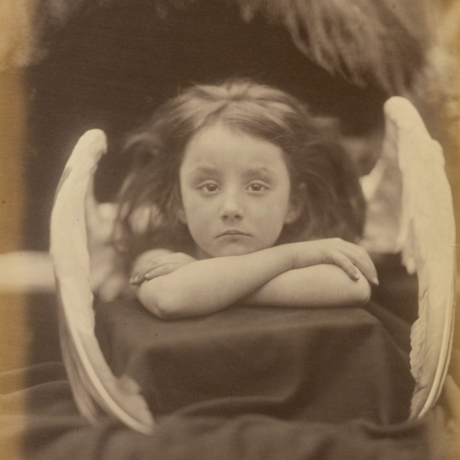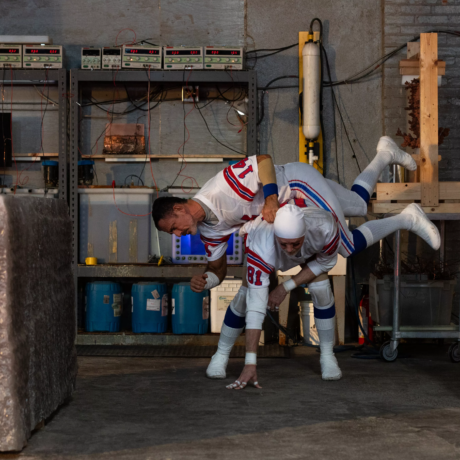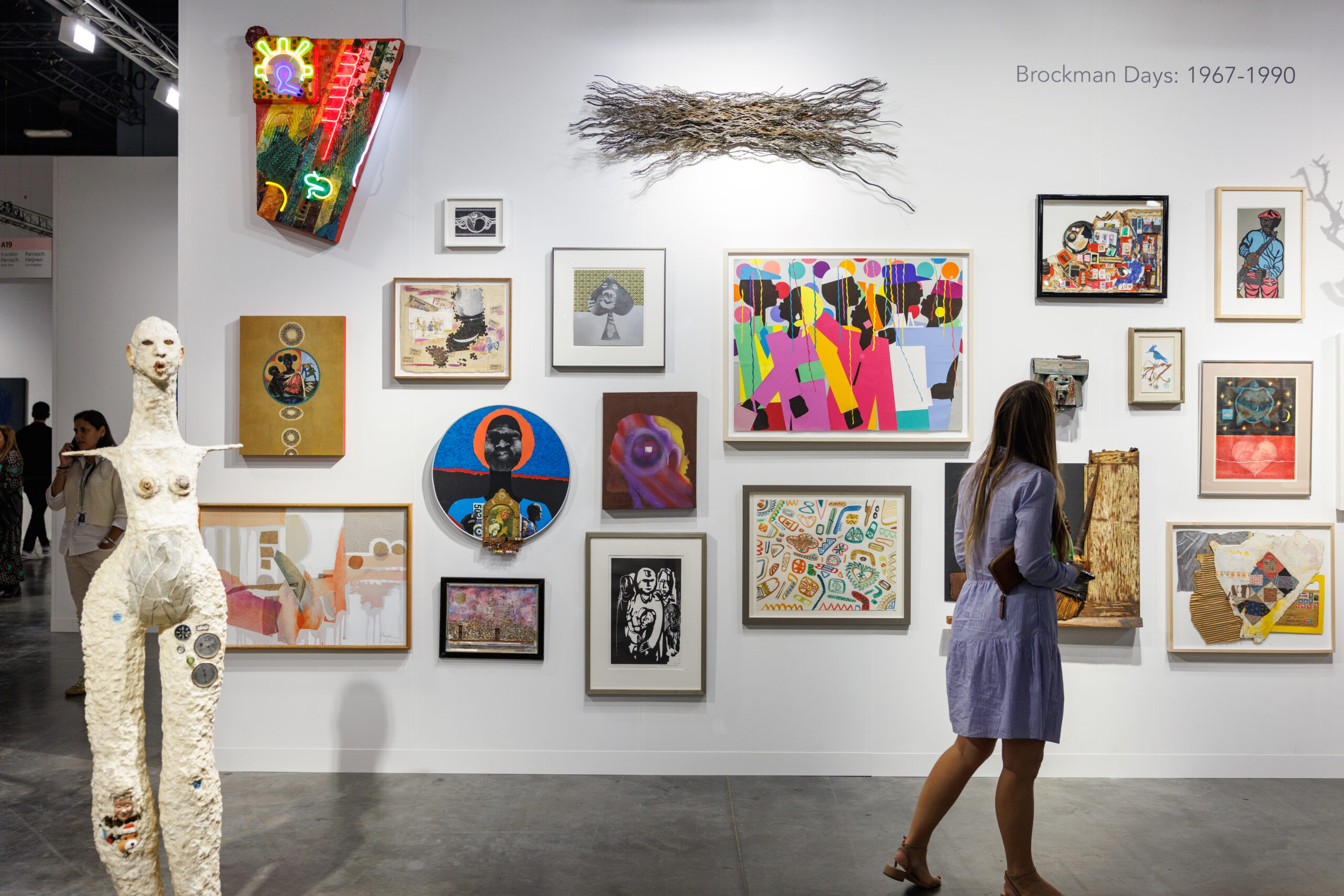
With 277 galleries from 39 countries, the 21st edition of Art Basel Miami Beach presents more showstopping art than could possibly be seen over its three-day public run from 8-11 December. This year’s fair offers a treasure trove of artists to discover, spotlighted in the especially strong Kabinett (curated presentations within gallery booths) and Positions (young galleries staging ambitious solo shows) sectors. In the former, strong female narratives come to the fore through spotlights on intrepid artists, such as Leonor Fini and Betty Tompkins, while in the latter, contemporary artists Cynthia Talmadge and Nickola Pottinger revive the past in beguiling ways. Ahead, preview our top ten must-see booths, which demonstrate brilliant storytelling and immersive scenography, while also providing a preview of artists with upcoming shows at institutions around the globe.
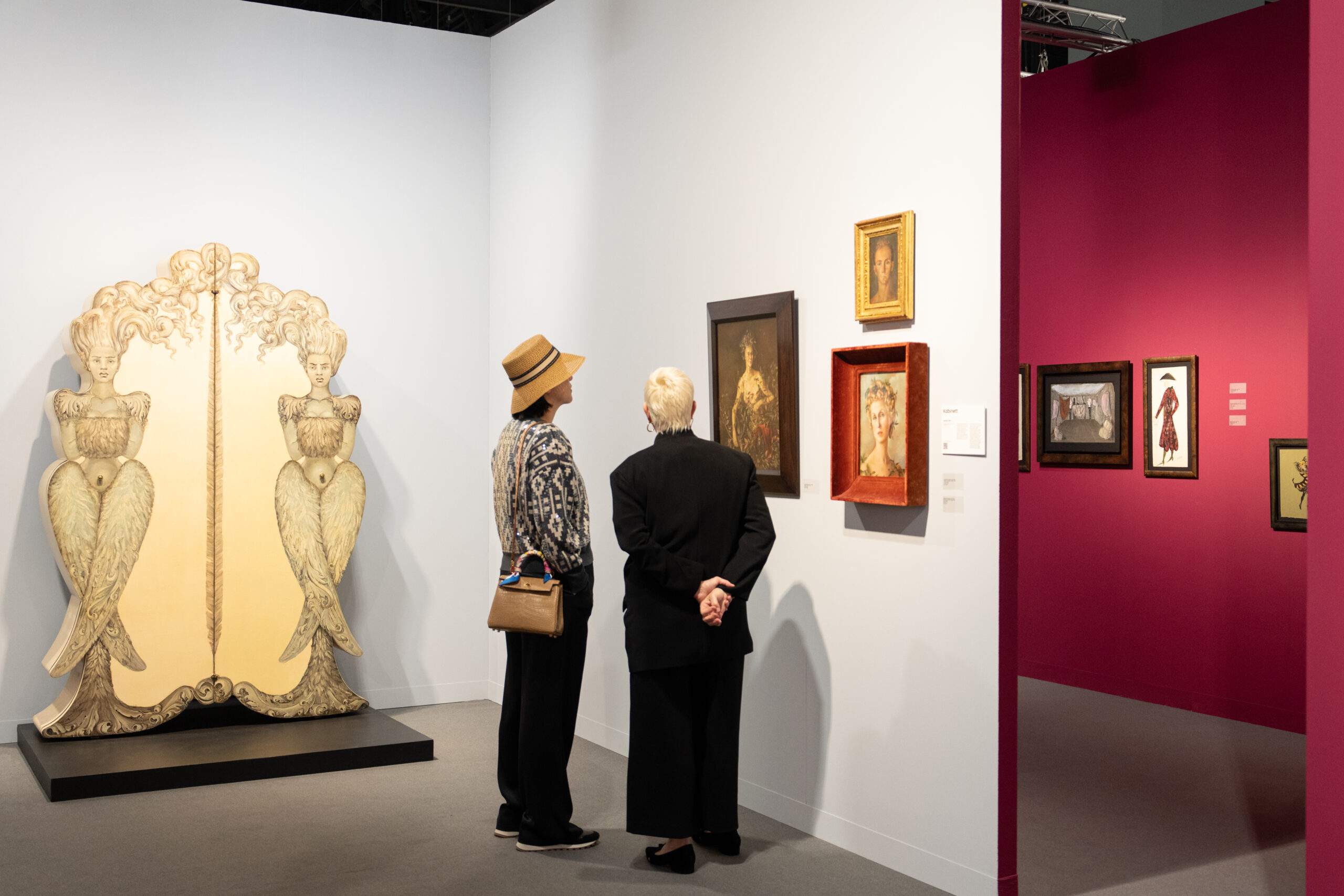
Galerie Minsky and Weinstein Gallery
One of the most buzzed-about booths at this year’s fair — and for good reason — represents a partnership between Galerie Minsky, Paris, and Weinstein Gallery, San Francisco, two of the foremost experts on Argentinian artist Leonor Fini. Magenta walls and a selection of handmade masks designed by the enigmatic woman, best known as a Surrealist, though she never identified as one, lure visitors in where they will discover a retrospective-style selection of paintings, watercolours, costume and set designs, furnishings, and more by the singular artist, known as much for her eccentric persona as challenging the status quo with her daring depictions of sexuality.
“It is our hope that our solo presentation focused on over six decades of her work will show both collectors and art lovers the brilliance and importance of this often overlooked and underappreciated artist,” Kendy Genovese, Weinstein Gallery Director and Curator, tells Elephant, adding that Galerie Minsky founder Arlette Souhami was Fini’s original dealer. A major Fini exhibition will open during fall 2024 at the Palazzo Reale, Milan, followed by additional shows in 2026 in Germany and France.

Lehmann Maupin
Lehmann Maupin may just be the gallery of the moment, thanks to numerous international commissions and a bevy of institutional blockbusters around the corner from artists on their roster. In addition to Hernan Bas: The Conceptualists, which just opened at Miami’s Bass Museum, the gallery’s artists’ upcoming shows include Teresita Fernández at SITE Santa Fe, Tammy Nguyen at ICA Boston, and Lee Bul’s façade commission for The Met, among others. “If the first hours of the fair are an indication of what is to come, we are feeling very optimistic!” David Maupin, the gallery’s co-founder tells Elephant.“Art Basel Miami Beach continues to be one of the most important art fairs for us…Collectors are here from all over the world — from Beijing to Sao Paulo — and are eager to expand their collections and discover new artists along the way.”
While knockout works by these artists are on view at Lehmann Maupin’s ABMB booth, don’t miss the gallery’s Kabinett section devoted to OSGEMEOS, who will also have a solo show at the Hirshhorn Museum and Sculpture Garden during spring 2024. A psychedelic, wallpaper installation presents new works by twin brothers Gustavo and Otavio Pandolfo, known for their long-limbed yellow characters, combining traditional elements of their Brazilian culture with iconography from graffiti, music, and international youth culture.
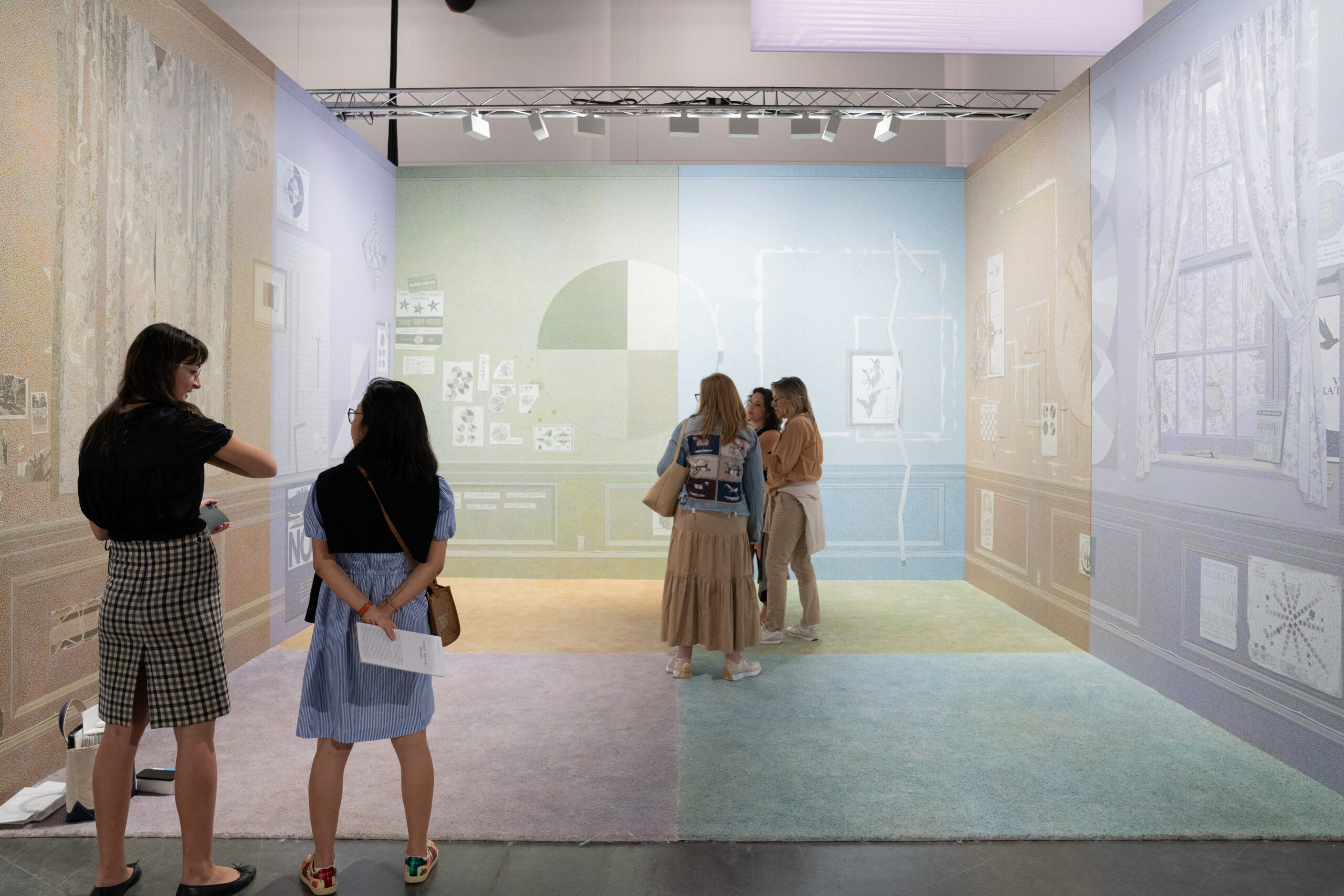
56 Henry
A standout of the Positions sector is New York’s 56 Henry, spotlighting the work of Brooklyn-based artist Cynthia Talmadge whose installation is as fascinating as the story that inspired it. Talmadge’s distinctive œuvre combines a pastel, pointillist sensibility with dark Americana subject matter and tabloid culture. Half Light,her fully immersive ABMB installation, imagines the studio of painter Mary Pinchot Meyer, through six large panel paintings and a hand-dyed carpet. In the 1960s, Meyer was working in Georgetown amongst artists in the Washington, D.C. Color School, such as Kenneth Noland and Anne Truitt. Meyer’s ex-husband Cord Meyer was a high-ranking C.I.A. official, and her friends included prominent political figures, most notably, President John F. Kennedy, with whom she was having an affair.
Talmadge’s paintings depict three different points on a timeline: 1963, the final year of her life; immediately following her mysterious unsolved 1964 murder (believed by many to have been a C.I.A. assassination — her diary was considered a significant piece of missing evidence for J.F.K.’s death); and a counterfactual 1969, imagining her life and career had she still been alive. “The 1960s has always been a fascination for Cynthia,” 56 Henry owner Ellie Rines tells Elephant of the artist who had lived in D.C. and whose last show at the gallery was centred around Marilyn Monroe’s relationship with her psychiatrist.

Yares Art
Yares Art’s ABMB presentation coincides and expands upon its New York gallery’s concurrent 60th Anniversary Exhibition, which memorialises founder Riva Yares and her six-decade career championing Modern art titans. Eminent art critic and poet, Edward Lucie-Smith, described Riva’s “unique personal qualities” as including “a hunger for visual sensations,” and, indeed, with numerous monumental canvases on view, the gallery’s Miami presence will satiate all appetites for museum-quality paintings.
Works by Helen Frankenthaler, Morris Louis, Robert Motherwell, and Milton Avery join the fair’s most valuable piece this year: a $45-million Frank Stella. Delta (1958) is the artist’s first “Black Painting,” featuring black bands alternating with strips of a deep reddish-brown underpainting. According to David Yares, Stella had kept the piece, also featured in the 2015 Whitney Museum of American Art retrospective, in his personal collection for many years due to its significance in his career and the movements of Color Field painting, Minimalism, and conceptual art. Yares likens Delta to Picasso’s Les Demoiselles d’Avignon.
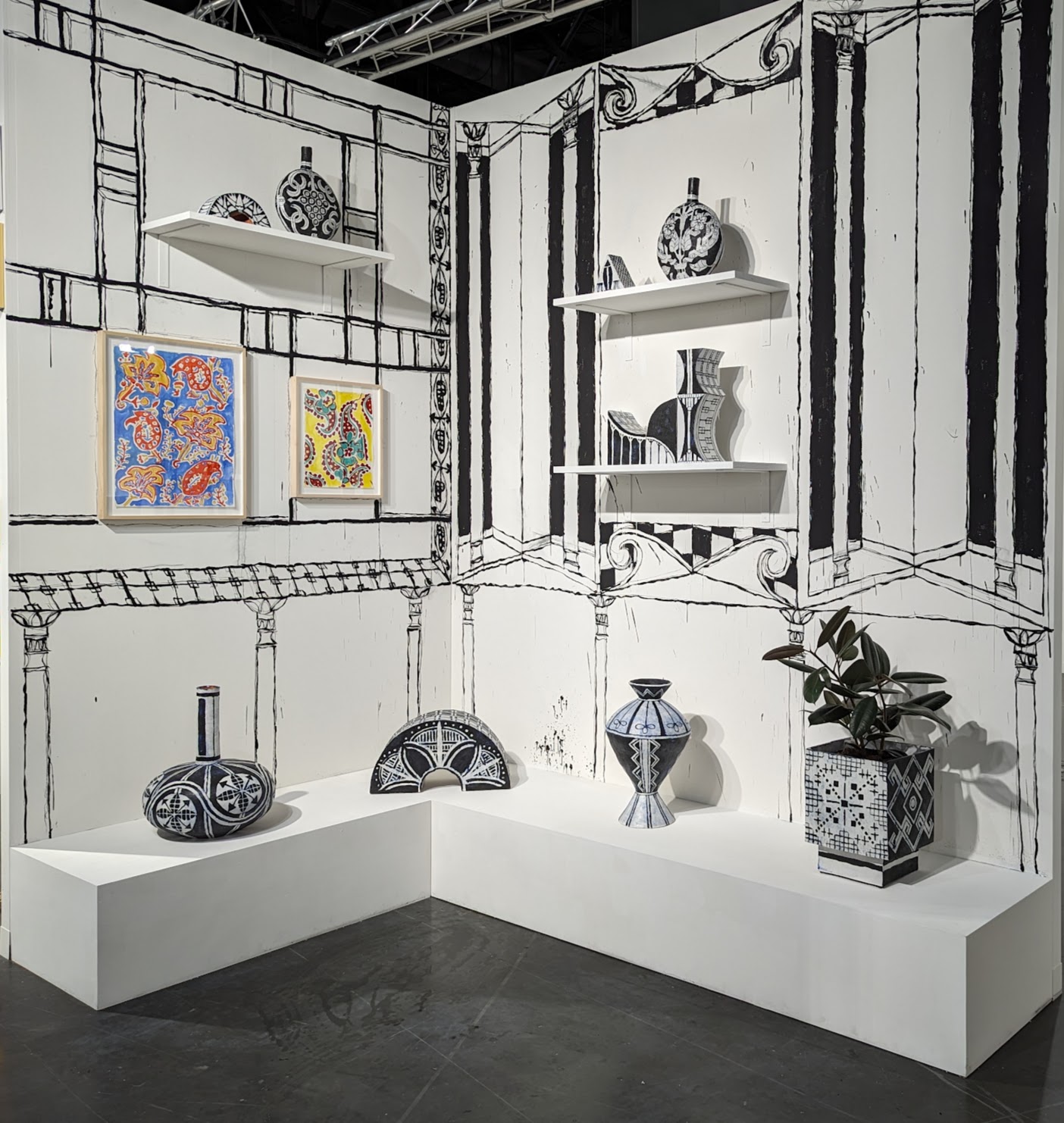
Canada
For its Kabinett contribution, New York’s Canada gallery highlighted the bluish-black-and-white ceramics and vibrant watercolours of Elisabeth Kley in a site-specific installation called “Café Cleopatra.” The New York-based artist’s works flank the booth’s entrance, where her whimsical architectural patterning forms an eye-catching hand-painted mural. From ancient Egyptian design and the Wiener Werkstätte to modern art and drag performances, the inspiration for Kley’s geometric and plant motifs runs the gamut.
The gallery’s highly graphic works continue upon stepping inside the booth, where Joan Snyder’s mixed-media canvases, Luke Murphy’s LED patterned towers, Katherine Bernhardt’s trippy acrylic and spray-paint creations, and Scott Reeder’s Miami Vice-hued paintings are just a smattering of the works that deliver an explosion of colour.
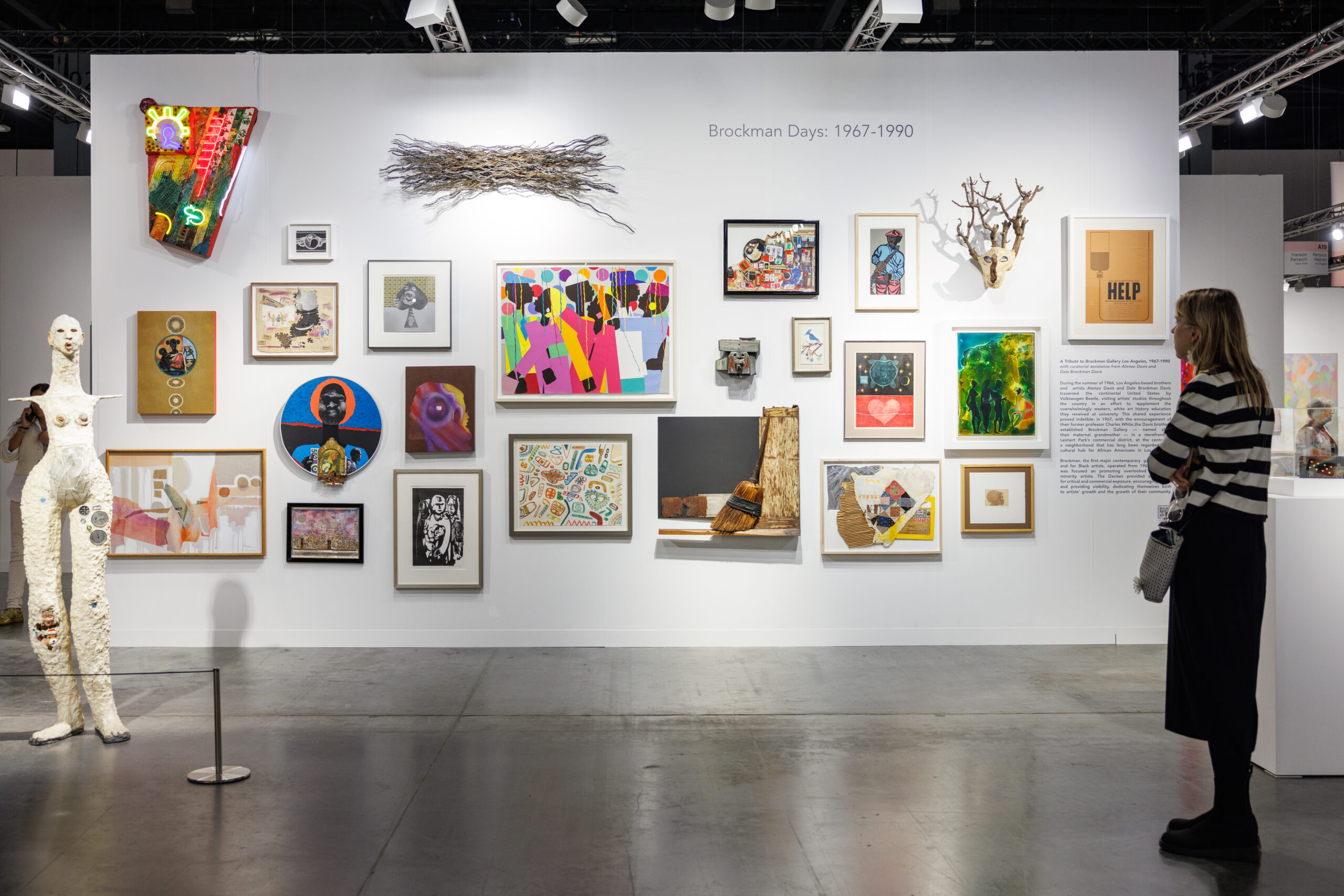
Parrasch Heijnen and Franklin Parrasch
New York’s Franklin Parrasch and Los Angeles’s Parrasch Heijnen galleries have jointly curated one of the fair’s most important and eye-opening presentations: the first-ever tribute exhibition to Brockman Gallery, America’s first major contemporary gallery run by and for Black artists and artists of colour. The gallery’s co-founders, LA-based brothers Alonzo Davis and Dale Brockman Davis, assisted in the curation, which showcases their own works alongside artists including David Hammons, Maren Hassinger, Betye Saar, John Outterbridge. The diversity of media on view, which ranges from found tree fragments to neon lights, have an instant visual impact, which will hopefully inspire today’s curators and scholars to delve more deeply into these artists, still largely undersung.
Operating between 1967-1990, the gallery was established after the summer of 1966 when the Davises ventured across the United States via their Volkswagen Beetle to discover artists that would challenge the “overwhelmingly western, white art history education they received at university,” as the tribute materials describe. The gallery’s contribution of providing a platform for critical and commercial exposure undoubtedly paved the way for overlooked minority artists, while also uplifting the wider Leimert Park neighbourhood, where it operated, with concerts, film festivals, and community events.
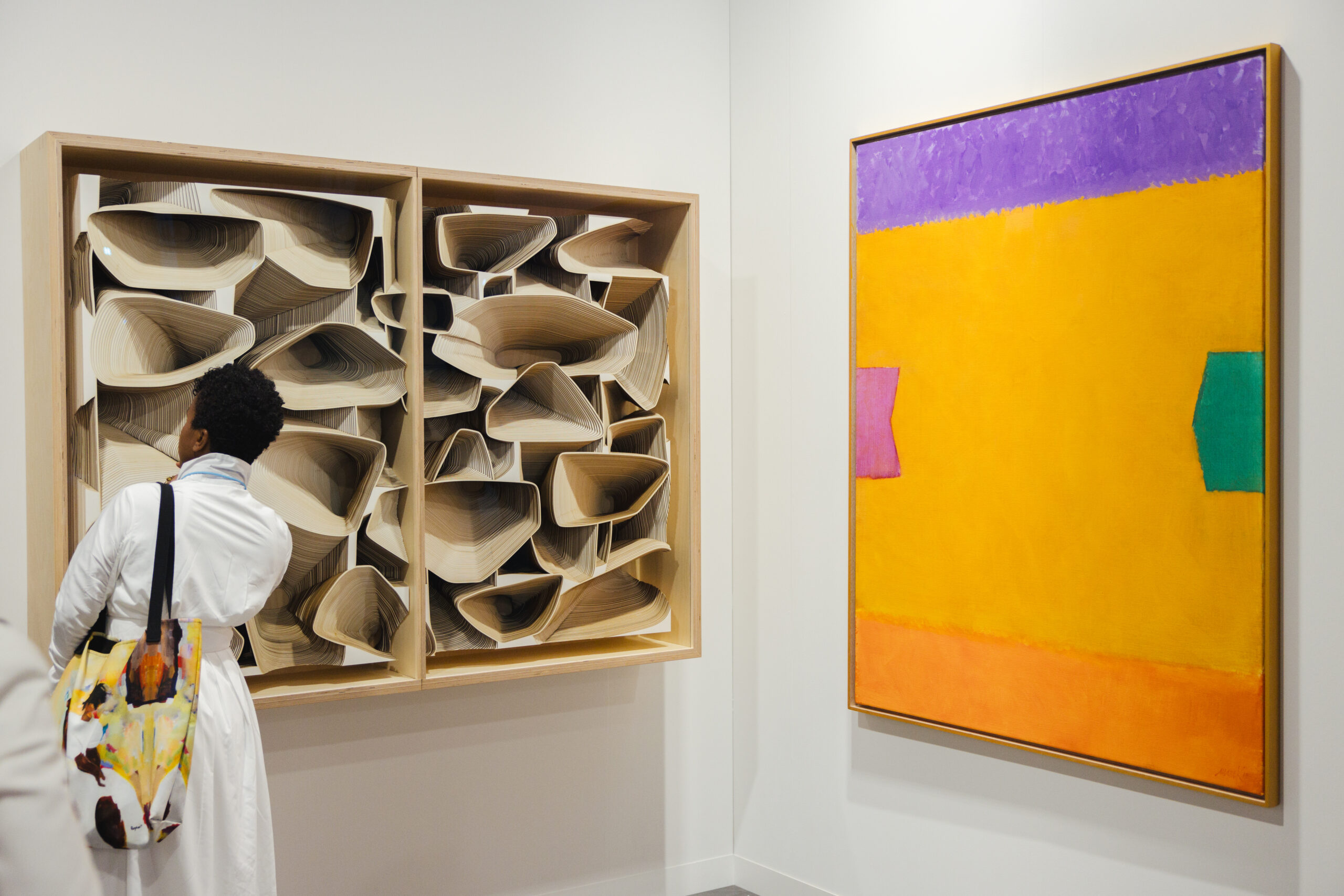
Nara Roesler
Brazilian contemporary art gallery Nara Roesler masterfully curated its ABMB booth with a refreshing mix of artists across generations from both the Americas and Europe. The abstract and figurative works on view are elegantly united in their architectural approach. Bridging the gap between sculpture and decorative arts, two highlights include Brazilian artist Lucia Koch’s New system: Cross (Rouge) (2022), which consists of her signature draped textile in a tonal gradation that subtly shifts as the light filters through the fabric, and Jose Dávila’s Aporia (2023), a one-way mirror sandwiched between a metal corten steel tube and a block of raw marble.
Sculpture by Brazilian artists, Artur Lescher and Raul Mourão, and Cuban artist Marco A. Castillo play with geometry, materiality, and dimension, while paintings by Brazilian artists, Daniel Senise, Elian Almeida, and Fabio Miguez, depict architectural structures and interiors ranging from the decorative to the minimalistic. Another highlight is Rio de Janeiro-born and based André Griffo’s Farm management instructions 9 (2023). From afar, the entrancing religious scene appears like a photograph, while up close, the viewer can appreciate not only the artist’s painterly aptitude, but also the darker message behind the work. Pictured below the intricate floor’s surface are miniature figures who appear to have built the land this religious site stands on. Utilising his architectural background, Griffo’s practice blends historical and contemporary settings with symbols to illustrate how power structures, such as Brazil’s history of slavery, has lingering effects today.

PPOW
Of the many (and all worth seeing) Kabinett exhibitions devoted to female artists, New York gallery PPOW’s presentation on Betty Tompkins, known for her erotic assemblages, is a standout. “In preparation for Betty’s third solo show with the gallery in summer 2024, we uncovered her ‘Defacements’ series of historic works on paper,” PPOW Gallery Director Ella Blanchon tells Elephant of the decision to spotlight the American artist. “These are a significant, overlooked bridge between her iconic, sexually explicit paintings and her more recent works on art history book pages. The intimate scale and delicacy of these vibrant landscapes also revealed a unique side of her practice which felt like a perfect Kabinett for people familiar with her work and those just discovering it.”
In these ‘Defacements,’ which date between 1992 and 2003, Tompkins appropriated vintage images created for the male gaze, sourced from Taschen books on softcore portraiture. Her recontextualization of the women’s brazen poses in Impressionist-like landscapes lends them a mischievous, whimsical, and cheeky charm — pun intended.
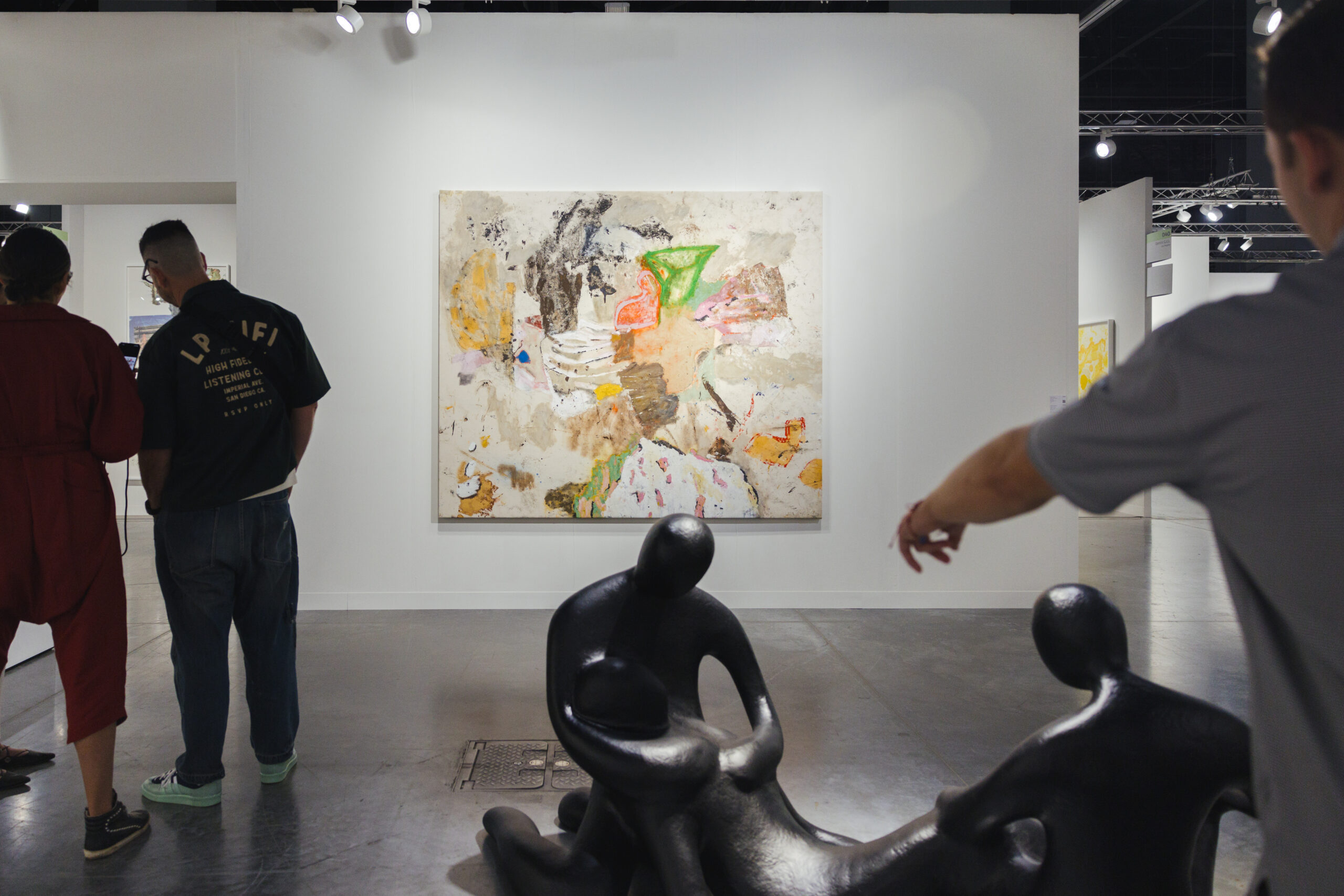
OMR
Mexico City’s OMR’s booth offers a visually striking curation of works by artists across the Americas and Europe, many of which speak to the climate crisis. Just outside one of the booth’s entrances are two of Swiss artist Claudia Comte’s white Carrara marble cacti. Although the sculptures’ silhouettes are cartoonish, the cactus stands as an eblem of desertification for Comte, and is one of many symbols she uses to illustrate the harmonious coexistence of the natural world and the many species that inhabit it. Also on view is Compte’s An Offshore Oil Refinery (hahaha painting) (2022), which directly critiques peoples’ cavalier attitude toward the ongoing ecological disaster.
Many other works incorporate plant imagery (SUPERFLEX’s Investment Bank Flowerpots/Deutsche Bank (2021), a series in which the Danish art collective transforms models of the world’s largest investment banks into flowerpots) and stones (Polish artist Alicja Kwade’s Calder-like mobile, Heavy Skies (2023)) in poignant ways. Though it is not necessarily connected to the theme, Chilean artist Sebastian Silva’s seven-foot-tall Untitled canvas reflects the artist’s — better known as an award-winning film director — penchant for sketching and gestural brushwork, which is quickly garnering international acclaim, too.
Mrs.
Another highlight of the Positions sector comes from New York gallery Mrs. who is showcasing new sculptures by Jamaica-born, New York-based artist, Nickola Pottinger. The artist’s works are deeply personal and connected to her heritage, while also exploring themes of folklore and reincarnation — she refers to this series as “duppies,” Jamaican Patois for “ghosts.” Using paper pulp from old family documents, Pottinger moulds figures with features from both humans and mythological creatures. In Ah suh dem gwaan, a chair’s arms are replaced with two shut-eyed faces that appear to be serenely sleeping. In Dumpling, two figures embrace, only their visages and feet emerge from a stone-like structure. Textural, eerie, and captivating, these hybrid figures walk the line between functional and decorative, dead and alive.
Chairs, benches, potholders, and accessories, passed down from her family, are also incorporated into her work, embedding them with tangible memories. Pottinger additionally address how climate change and tourism are affecting Jamaica’s forests and beaches by garnishing her sculptures’ surfaces with moss. On the rise, Pottinger will have a solo show with the gallery in January 2024, followed by one at The Aldrich Contemporary Art Museum in Connecticut in 2025.
Words by Stephanie Sporn. Images courtesy of Art Basel Miami Beach.
